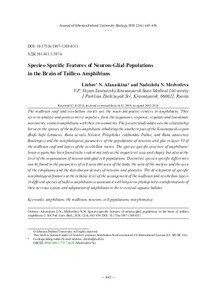Видовые особенности нейрон-глиальных популяций головного мозга бесхвостых амфибий
Скачать файл:
URI (для ссылок/цитирований):
https://elib.sfu-kras.ru/handle/2311/128440Автор:
Афанаскина, Л.Н.
Медведева, Н.Н.
Afanaskina, Liubov’ N.
Medvedeva, Nadezhda N.
Дата:
2019-12Журнал:
Журнал Сибирского федерального университета. Биология. Journal of Siberian Federal University. Biology 2019 12(4)Аннотация:
Крыша среднего мозга и кора мозжечка являются у амфибий ведущими интегративными
центрами. Они обеспечивают анализ и обработку нервных импульсов, формирование
ответной реакции организма, регуляцию и координацию движений, связь земноводных с
условиями среды. В работе рассмотрена связь между видовой принадлежностью бесхвостых
земноводных южной части Красноярского края (Bufo bufo Linnaeus, Rana arvalis Nilsson,
Pelophylax ridibundus Pallas, Rana amurensis Boulenger) и морфологическими параметрами
популяций нейронов и глии VI слоя крыши среднего мозга и слоев коры мозжечка. Установлено,
что видовые особенности строения отделов головного мозга амфибий проявляются не только
на органном уровне (размеры и форма), но и на уровне организации клеточных популяций
нейронов и глии. Отличительные видовые особенности отмечены в параметрах площади
клеток (площадь тела – Sт, площадь ядра – Sя и площадь цитоплазмы – Sц) и плотности
распределения нейронов и глиоцитов. Появление у разных видов бесхвостых земноводных
специфических морфологических особенностей на клеточном уровне организации слоев среднего
мозга и мозжечка, вероятно, связано с длительными филогенетическими преобразованиями
их нервной системы и адаптацией амфибий к наземно-водной среде обитания The midbrain roof and cerebellum cortex are the main integrative centers in amphibians. They
serve to analyze and process nerve impulses, form the organism’s response, regulate and coordinate
movements, connect amphibians with their environments. The present study addresses the relationship
between the species of the tailless amphibians inhabiting the southern part of the Krasnoyarsk region
(Bufo bufo Linnaeus, Rana arvalis Nilsson, Pelophylax ridibundus Pallas, and Rana amurensis
Boulenger) and the morphological parameters of the populations of neurons and glia in layer VI of
the midbrain roof and layers of the cerebellum cortex. The species-specific structure of amphibians’
brain regions has been found to be evident not only at the organ level (size and shape), but also at the
level of the organization of neuron and glial cell populations. Distinctive species-specific differences
can be found in the parameters of cell area (the area of the body, the area of the nucleus and the area
of the cytoplasm) and the distribution density of neurons and gliocytes. The development of specific
morphological features at the cellular level of the arrangement of the midbrain and cerebellum layers
in different species of tailless amphibians is associated with long-term phylogenetic transformations of
their nervous system and adaptation of amphibians to the terrestrial-aquatic habitat

